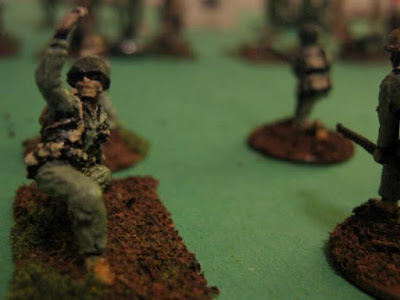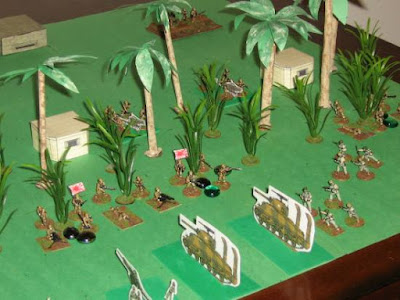I'm a dungeon crawl-addict. I like dungeons. I like fighting goblins and kobolds and skeletons. And I'm unapologetic about it.
This weekend, we've got family in town and they will be here for a week. I won't have much free time to game. When I do, I'll probably run myself through a dungeon.
Sometimes, I'll use the wandering monster tables for each encounter, but just as often, I want a more themed dungeon or dungeon area. As with solo gaming, I don't mind if I know what I'm facing ahead of time, but I want to make sure there's surprise and some control wrestled away from me.
This is just one of the ways I do it.
Warning: The feel is certainly not that of a GM'd game, but it is enjoyable, with lot's of opportunity to add a narrative if I desire to. The ideas here are culled from a variety of sources and I suspect most long time solo rpg players probably do something similar.
This is also a longer than usual post - my apologies. I hope you find it worthwhile.
Randomized Themed Encounters
Although I use this method with my
d12 dungeon generator, you don't need a dungeon generator - the highest number encounter can be the exit or steps down, etc. I also sometimes use minis for the combat and sometimes not - either way you like it, this method won't infringe on your choice.
Option 1: Decide on the number of encounters you want to have and write them up (detailed or sketches, your call) - The number should correspond to the highest value you can roll on any one of your available dice that you choose. That is, 6 on a 1d6, 12 on a 1d12, etc. Roll the dice, play out the appropriate encounter.
Option 2: The method I prefer is similar to that found in
Chronicles of Arax and
H.E.X. If you have any experience with either, then you have an idea of what's coming.
Decide how many encounters you want to have maximum and write them up.
Pick a die - the die's maximum value must be at least half of the total number of encounters.
That is, if you want 8 encounters total, you need to roll at least a d4 and no more than a d8, if you want 5 encounters, you need at least a d3(well a d6 but 1-2= 1, 3-4=2, 5,6 = 3) and no more than a d5, and so on.
Each time you roll, you add your Success Total to the value shown on the die. Your Success Total is the measure of encounters you make it through successfully. It starts at 0, naturally enough.
For each successful encounter, you'll add +1 to the Success Total . If it's unsuccessful, you don't get to add anything, but you don't lose anything.
Example:
- I decide on 10 encounters maximum and I'm rolling a d6.
- At the start, my Success Total = 0 (my d6 results in values 1-6)
- First roll = I roll a 2 and add my Success Total for a total of 2. I play and survive the encounter.
- Success Total = 1 (my d6 now yields values from 2-7)
- Second roll = I roll a 5 and add my Success Total for a total of 6. I play and survive encounter #6 and survive.
- Success Total = 2 (my d6 yields values from 3 to 8)
- Third roll = I roll a 2, add my Success Total for a total of 4. I play encounter #4 and fail.
- Success Total = 2 (my d6 again yields values from 3 to 8)
- etc.
And finally, one additional wrench in the works whether you're playing Option 1 or Option 2:
- HEX option: If the total is an encounter you played already, play it again (when combined with the Variable Enemies below, the encounter may very well not be exactly the same).
- Arax-like Option: If the total is an encounter you played already, play the next lowest numbered encounter that has not already been played. If everything lower has been played, play first available encounter higher than the your total.
Variable Enemies
I may know which enemies I'm going to encounter, but the above method means I won't know in what order exactly. To really keep me on my toes, I use an idea from wargaming: variable force strength (which appears in b/x as "Number Appearing", for a wargame example, see PEF resolution in CR3: FV from Two Hour Wargames).
Example:
Encounter 1 = A horde of unruly goblins.
Roll 1d6
1 =
There are 1/2 the party size goblins
2-5 =
There are the same number of goblins as there are party members
6 =
There are 2x as many goblins as party members
Obviously you can take this as far as you want. How so?
Change option 6 to:
2x as many goblins as party members. Roll 1d6 = 1 = all have cross bows and melee weapons, 2-5 = all have melee weapons, 6 = 1/2 ranged weapons and half melee.
Or maybe:
2x as many goblins as party members. Roll 1d6. On a 1 or 2, there is 1d4 dire wolves present as well.
Throw in the reaction chart from b/x or Labyrinth Lord and not only do you not know how many will be there, you don't know if they'll attack immediately or if they'll give you a chance to bluff your way through.
Add Mythic or something similar and you can take this much further than the basic concept of a simple dungeon invasion.
Putting it all together
Here's a real life sample of a dungeon adventure I threw together one afternoon, minus stats so you can use whatever system you prefer. Use some kind of reaction mechanism - either system specific or Mythic or "Yes, but" - to allow for alternatives to hack-and-slash, and to possibly tie the adventure into something larger, unless of course, you don't want to:
A band of goblins has been harassing caravans in the area (don't they always?). The party, guards on a caravan that was attacked, tracked them to their cave and journeyed inward cautiously . . .
Encounters (Roll 1d4, use Arax-like option)
1 – Room Trap (roll on table below)
2 – Monster1
3 – Empty
4 – Monster2
5 – Monster3
6 - empty
7 – Room Trap with Treasure (roll on table below)
8 – Monster4
Room Traps
1 - Poison Cloud Save vs Poison or Die
2-3 - Bucket of Spiders, Save vs
Paralysis or flee the dungeon
4-5 - Ye Olde Scythe Trap – Swings out
of ceiling and attacks 1st character as 2HD monster, 1d6+2 points of
damage
6 - Pit of Oil – trap door drops open,
roll for random character to fall in. Climbing out is impossible. 10' pole to fish out character Succeeds
on a 5 or 6. Human chain, succeeds 4-6, if fails,
next character in chain falls in too. Rope, succeeds 3-6, if fails, roll on
wandering monster table before next try.
Monster 1 – Unruly Goblins:
1 – ½ as many as party (min 1)
2 – 1 less than party (min 1)
3-4 Same as party
5 – 1 more than party
6 – 2x as many as party
Monster 2 – Elitist Wolf Riders
1-2 1 goblin and 1 dire wolf
3-4 2 goblins and 2 dire wolves
5-6 3 goblins and 3 dire wolves
Monster 3 – Bugbear Mercenaries
1-2 Party-2 (min 1)
3-4 Party -1/2 party (min 1)
5-6 Party -1 (min 1)
Monster 4 - The Big Boss
Maniacal Goblin Shaman(can cast Heal Light Wounds and Hold, HD:2, Save as C:2), Party +1 Fanatical Goblin Bodyguards + Treasure Horde
Good luck and happy dungeoneering!











































